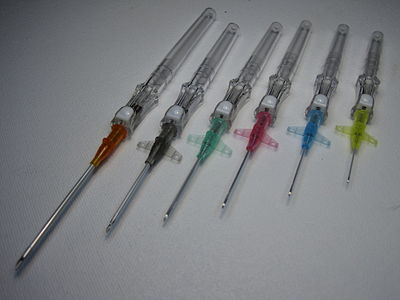Provision of venous access
Access to the venous bed is possible in three ways:
- Venepuncture – stabbing a vein and inserting a cannula or catheter:
- peripheral veins – in the elbow socket (v. basilica, v. cephalica), on the forearm and the back of the hand;
- central veins – subclavian vein, external or internal jugular vein, rarely femoral vein (central venous catheter = catheter, the end of which lies in the vena cava).
- Venesection – surgical exposure of the vein, its opening and insertion of the cannula (if it is not possible to perform a venipuncture, e.g. if the veins are collapsed due to heavy blood loss) – v. basilica, v. cephalica, , v. jugularis externa, v. saphena magna.
- Intraosseous venous access – if the attempt to cannulate the vein is unsuccessful, a special threaded needle is inserted into the marrow of the long bones (tibia under the tuberositas tibiae, distal part of the femuru, above the inner ankle, into the spina iliaca)
Venous accesses are used for the application of intravenous infusions ( indications : administration of substitute solutions in case of blood loss, during anesthesia, long-term administration of antibiotics , parenteral nutrition... ) or of blood transfusions , or for monitoring hemodynamics (measurement of central venous pressure…).
When deciding on venipuncture or venesection, we prefer the HK or the neck (there is a risk of phlebothrombosisin DK ) and we perform it as peripherally as possible (so that the same vein can be punctured multiple times) and if possible not above the joint (so that the patient is not limited in movement).
Advantages and disadvantages of individual types of approaches[edit | edit source]
| Input Type | Benefits | Cons | Maximum boot time |
|---|---|---|---|
| Peripheral cannula | Quickly and easily accessible Low risk of complications Large peripheral cannulas allow the greatest flow during massive volume replacement Low risk of complications |
It is not possible to apply all types of drugs (vasoactive substances, parenteral nutrition) The periphery may not have quality veins for puncture |
It depends on the presence of local complications (inflammation, pain, ...), the manufacturer's instructions, the type of catheter and the practice of the workplace. Usually about 5 days |
| Central Venous Catheter | All medications can be administered Enables measurement of central venous pressure Can be introduced even with bad peripheral veins |
Must be administered by a trained physician Risk of complications (PNO, puncture of the artery) |
It depends on the presence of local complications (inflammation, pain, ...), the manufacturer's instructions, the type of catheter and the practice of the workplace. Usually for non-tunneled catheters about 14 days Tunnelized catheters and subcutaneous ports can be used for months to years |
| Intraosseous Entry | Quick introduction even by a paramedic Safety of entry in case of bad periphery All medicines can be administered Quick onset of effect |
High risk of infection Difficult handling Risk of dislocation and bleeding |
12 hours, exceptionally 24 |
| Venesection | An exceptional approach when a puncture catheter cannot be inserted, usually successful | Operative approach with the necessity of anesthesia and related complications, higher risk of local complications | It depends on the type of catheter inserted |
Techniques of puncture approaches[edit | edit source]
- Catheter through the needle;
- catheter through the needle
- catheter through the cannula;
- along a wire conductor ( Seldinger technique).
Complications of venous access[edit | edit source]
- Vein puncture;
- paravenous application of the drug;
- air embolism;
- inflammation and thrombosis at the injection site;
- pneumothorax, hemothorax;
- for long-term inserted catheters: thrombosis, infection or catheter sepsis.
Due mainly to infectious complications, it is necessary to remove every catheter that will not be used any further, where complications have occurred (swelling, redness, pain, ...) and also replace within 48 hours a catheter that was inserted under non-standard conditions (for example, RZP) .
Peripheral vein securing procedure[edit | edit source]
We perform on an accessible peripheral vein. Most often in the basilic vein, cephalic vein, veins on the forearm, back of the hand. In exceptional cases, the veins of the lower limbs or the neck can also be used. We proceed similarly to taking venous blood. We always work with gloves.
- Applying a tourniquet;
- finding a suitable vein;
- careful disinfection of the injection site;
- inserting a cannula into a vein;
- releasing the tourniquet;
- securing the cannula against movement;
- removing the needle and leaving the plastic catheter;
- connection to the appropriate infusion.
Color marking of peripheral venous cannulas[edit | edit source]
| Color marking of venous cannulas | |||||||
|---|---|---|---|---|---|---|---|
| Size in Gauge | 24 | 22 | 20 | 18 | 17 | 16 | 14 |
| Colour | yellow | blue | pink | green | white | grey | orange |
| Outer diameter
(mm) |
0,7 | 0,9 | 1,1 | 1,3 | 1,5 | 1,7 | 2,2 |
| Inner diameter
(mm) |
0,4 | 0,6 | 0,8 | 1,0 | 1,1 | 1,3 | 1,7 |
| Flow
(ml/min) |
13 | 36 | 61 | 103/96 | 128 | 196 | 343 |
| Length of injection
(mm) |
19 | 25 | 33 | 33/45 | 45 | 50 | 50 |
Links[edit | edit source]
Related articles[edit | edit source]
- Providing Peripheral Venous Access - Detailed
- Central venous catheter
- Central vein cannulation (pediatrics)
- Arterial Catheter
- Arterial cannulation - detailed
- Swan-Ganz Catheter Insertion (Paediatrics)
- Intraosseous infusion
- Seldinger Technique
External links[edit | edit source]
- Peripheral vein cannulation
- Overview of approaches to the venous bed – including intraosseous access
Source[edit | edit source]
- PASTOR, Jan. Langenbeck's medical web page [online]. [cit. -]. <http://langenbeck.webs.com>.




